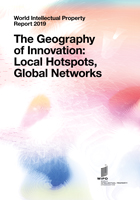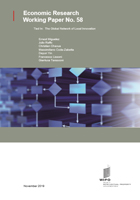Innovation Hotspots: The Importance of Making Connections
Just as people benefit from making connections in social and working environments, hotspots cross international borders to seek partners for innovation. Making these connections and choosing the right partners is increasingly important.

The end of the solitary genius?
The production of scientific and technological knowledge has become increasingly collaborative. Over the past 20 years, the rise of collaborative team efforts have made lone wolf scientists an endangered species. Most scientific knowledge is produced in teams of six or more scientists. Teams collaborating to achieve technological innovations follow a similar trend.
Most high-income economies also show a rise in international collaboration. While the scientific community has a long tradition of engaging in international cooperation, the improvements in communications have helped scientists share and coordinate their efforts in an increasingly efficient manner. Additionally, multinational companies seek efficiency gains from the international division of their R&D and through international collaboration to:
- adapt technologies to different market needs;
- access a unique talent pool; or
- simply lower the researcher costs.
Innovation hotspots in the U.S. are among the most highly connected clusters in the world. The volume and frequency of collaborations with inventors and scientists residing in the U.S. make it central to the global innovation network. Other innovation hotspots that join their U.S. counterparts at the center of this global innovation network include Beijing, Bengaluru, Frankfurt, London, Paris, Shanghai, and Tokyo.
International co-inventorship and co-publishing, percent
How Globalized is Collaboration?
Increasingly, collaboration in scientific production (publication), as opposed to technological production (patent), involves teams from organizations in at least two countries. In only two decades, the share of international scientific collaboration increased by half, growing from 17 percent to 25 percent of scientific articles published. International co-inventorship is a much less frequent phenomenon.
Despite the lower shares, collaborative international patent production showed an impressive growth trend until the second half of the 2000s, more than doubling from less than 5 percent to almost 11 percent. Since 2010, the share has fallen slightly. The fact that international teams account for a higher percentage of published scientific articles than patents indicates that science production is more internationalized than technology production.
International co-inventorship (left) and co-publications (right), by country
Except for Japan and, to a lesser extent, the Republic of Korea, most top-filing countries show a large international co-inventorship share. The U.S. and Western European countries show mostly a rising trend. Smaller economies with internationally linked and dense urban and innovation areas – such as Switzerland – are very prone to engaging in international collaborations. India also shows a high rate of international co-inventorship. In East Asia’s top economies, things are different. Before the 2000s, the share of international co-inventorship in China was considerable, but the volume was small. After that, when the volume of Chinese patenting picked up, the percentage of international co-inventorship dropped dramatically, becoming comparable to the very low shares of Japan and the Republic of Korea.
Trends for international co-publication reveal a very different picture. All main scientific publishing countries have larger shares of international co-publication than co-inventorship, except for India. Moreover, these shares increased steadily over the period. However, the figures show East Asian countries being less internationally open than the U.S. and Western Europe when it comes to scientific publishing.
What do these connections look like?
International collaboration is also concentrated among a few major countries, although concentration decreases as new stakeholders enter the network. Scientific co-publishing and co-patenting between the U.S., Western Europe, and Japan account for almost half of the international ties.
New entrants to these networks – such as China, India, Australia, or Brazil – also mostly link with these three economies. However, even though the collaborations outside this triangle remain sparse, they have increased their participation reaching 13 percent of all international co-publications in 2011–2015.
Overall, collaboration is increasingly the norm. Collaborating and connecting to any one of these innovation hotspots facilitates the exchange of knowledge and even technological transfer to encourage more innovation worldwide.
Other stories you may enjoy

Running on Innovation
How the top 10 innovation-dense cities evolved since the 1970’s and see how The Race for Innovation is getting closer and closer.

How Policy may Redirect Innovation
Government policies can affect the rate and, to some extent, the direction of innovative activities. Some of these policies, such as R&D tax incentives, protection of IP rights, encourage innovation.
Related resources

The Geography of Innovation
The World Intellectual Property Report 2019 documents how the geography of innovation has evolved over the past few decades.

The Global Network of Local Innovation
In this paper we exploit a unique and rich dataset of patent applications and scientific publications...